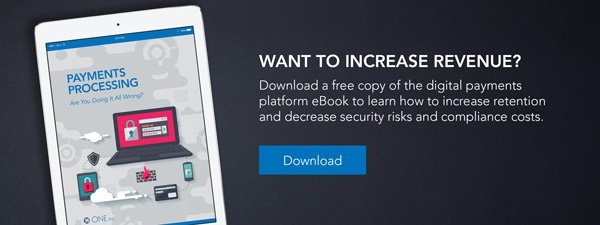I recently moved from Washington state to California. The moving truck driver—an owner-operator—was from Boston and ended up stuck on the west coast for two weeks because it was over Thanksgiving. Obviously, he wasn’t home to get his mail during that time.
What if he could receive a text while on the road which let him renew his policy with a simple 'yes' response?
Looking back at new customers of One Inc, we see a trend that will help policyholders such as this truck driver: insurers recognizing that the market has shifted, and they can no longer treat payment processing as nothing more than bill collection.
Our new customers are seeking integrated digital engagement experiences for policyholders. Call it “Phase Two” of digital engagement because it’s more than throwing up a website, or telling people to follow you on Facebook, or making your website mobile-friendly. Every touchpoint with a policyholder is an opportunity to build the digital relationship, and increase loyalty that drives retention.
And that means they are realizing they’ve been doing and thinking about payment processing all wrong.
There is no great insight in noting that consumers—especially those younger than the Baby Boomer generation—want to conduct business online. But if you talk to insurance industry analysts, they will tell you the industry has made little progress over the past couple years in responding to this shift.
That’s finally changing. We saw a commonality in the requirements of many new customers who chose One Inc recently. These customers include Capitol Insurance Group, Alfa Insurance, Bridger Insurance, Mendota Insurance Company, and others.
- They are integrating payments processing—both for premiums and claims payments—into their digital footprint. That means they are looking to move away from siloed, payment-processing-only solutions.
- They are setting up to connect with policyholders through multiple digital channels—omni-channel--such as email, IVR, and text.
- They are doing this for both inbound and outbound communications. Our customers who did outbound digital touches saw revenue and retention rise (“Hey, just a quick call about your policy expiring—say YES if you want to make a payment now and reinstate.”).
- They are doing it as an overall customer experience approach, including making it part of their customer portals rather than just hanging it off as a separate interaction. One of our employees put it this way, “These customers are paving the way for more effective digital engagement in 2018.”
Should anyone be surprised that policyholders don’t see it as a relationship if the only time they hear from you is when you want their money?
We interviewed a number of our customers who have moved in this direction and they told us another benefit of moving away from the generic payment processing vendors is that insurance-focused solutions deliver tailored operational improvements. These include PCI compliance scope reduction, greater security, and smoother reconciliation and routing.
We anticipate more insurers will dump their generic payment processing vendors and go with a built-for-insurance solution from a vendor who can give them the digital engagement capabilities to turn payment processing into a strategic advantage for customer retention. They will stop doing what they’ve always done, which is to pop up like a meerkat only every six months when it’s time to ask for renewal.
